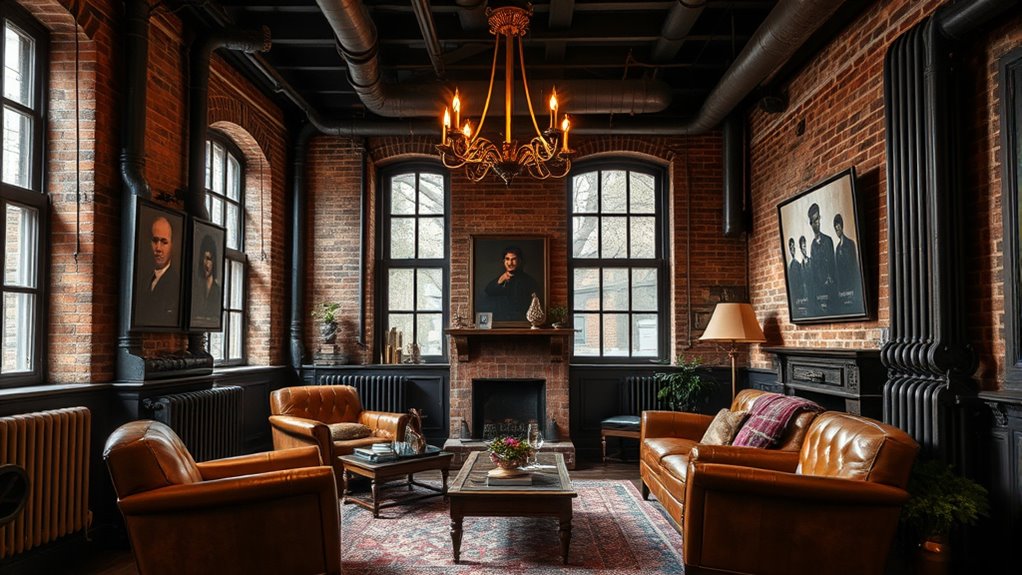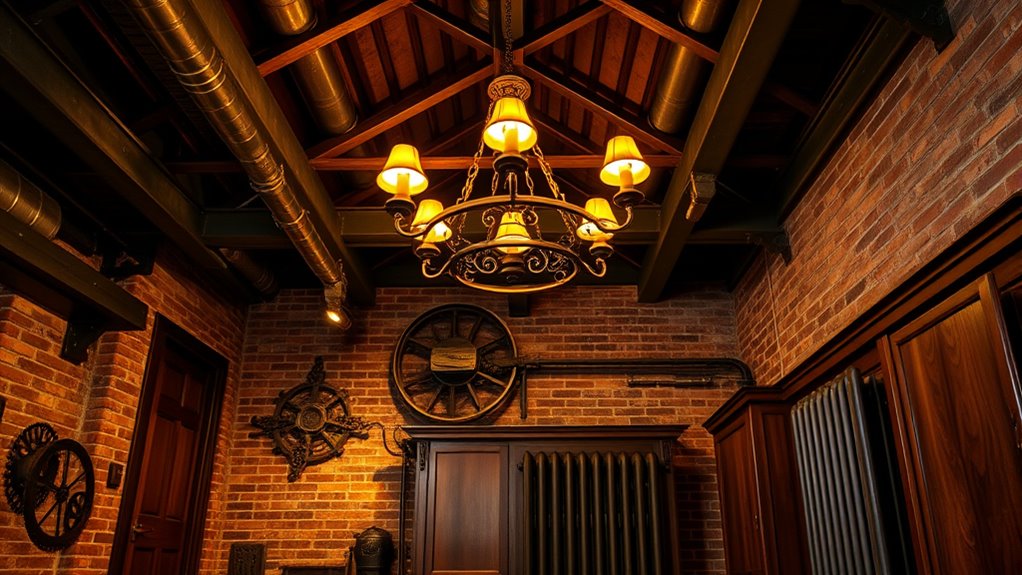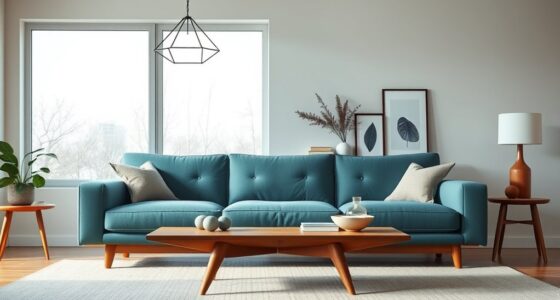The Industrial Revolution’s hidden impact on interior design is seen in how it introduced raw materials like steel, brick, and reclaimed wood, which still define modern spaces. It popularized open layouts, functional furniture, and durable fixtures rooted in factory environments. This style values practicality and authenticity, blending utilitarian elements with aesthetic appeal. If you continue exploring, you’ll discover how these industrial influences shape our homes and urban spaces today.
Key Takeaways
- The Industrial Revolution introduced raw materials like steel and brick, shaping the rugged aesthetics of modern interiors.
- Factory-style furniture, such as metal beds and lockers, became affordable and widespread, influencing everyday interior choices.
- Open-plan layouts with visible ductwork and large windows reflect factory design principles, emphasizing space efficiency.
- Use of industrial materials like concrete and metal enhances durability, reflecting the practical ethos of mass production.
- The shift toward functional, minimalist design with clean lines and utilitarian elements stems from factory and urban influences.

The Industrial Revolution transformed more than just factories and cities; it quietly reshaped the way we design and furnish our interiors. You might not realize it, but many elements of modern interior aesthetics owe their origins to this period’s innovations. One clear influence is the factory aesthetics that became embedded in interior design. These styles emphasize raw materials like exposed brick, steel beams, and reclaimed wood, creating spaces that feel both utilitarian and stylish. This look, once confined to industrial buildings, now appears in homes, offices, and cafes, giving interiors a sense of authenticity and rugged beauty. You can see this trend in open-plan layouts with visible ductwork and large windows, which evoke the expansive feel of factory floors.
Urban apartment styles, too, carry the legacy of the Industrial Revolution. As cities grew and demand for housing increased, adaptable, space-efficient designs gained popularity. These apartments often feature minimalist furniture, metal fixtures, and neutral color palettes—hallmarks of industrial design—aimed at maximizing space without sacrificing style. The shift toward compact, functional living spaces was driven by the need to accommodate a growing urban population, but it also influenced how you approach decorating smaller spaces today. You’re encouraged to blend form with function, using industrial-inspired elements that add character without clutter.
The rise of mass production during this period made furniture and fixtures more accessible and affordable, shaping the way interiors are furnished. You benefit from this legacy whenever you choose factory-style furniture—metal-framed beds, lockers repurposed as storage, or factory-style lighting with exposed bulbs. These elements reflect a practical, no-frills approach that celebrates craftsmanship and durability. The industrial aesthetic also promotes a sense of history and authenticity, encouraging you to incorporate vintage or reclaimed pieces into your home.
Furthermore, the Industrial Revolution’s influence extends beyond style to the very mindset of interior design. It shifted the focus toward functional, efficient, and straightforward spaces—values that continue to guide modern interior choices. You’re more likely to appreciate design that combines aesthetics with practicality, emphasizing clean lines, open layouts, and durable materials. This evolution, rooted in factory aesthetics and urban apartment styles, has created a versatile, timeless look that remains popular today. Whether you’re decorating a cozy city apartment or a spacious loft, the echoes of the Industrial Revolution are woven into your choices, subtly shaping the spaces where you live and work. Additionally, the use of industrial materials like metal and concrete often enhances durability and longevity, reinforcing the practical ethos that originated during this transformative period.
Frequently Asked Questions
How Did Industrial Materials Influence Modern Furniture Design?
You see, industrial materials revolutionized modern furniture design by enabling factory-made pieces, which made furniture more accessible and affordable. Material innovation introduced new textures, durability, and sleek aesthetics, inspiring minimalist and functional styles. This shift allowed designers to experiment with metals, plastics, and engineered woods, transforming interiors with innovative, durable, and stylish furniture. Your space benefits from these advancements, blending practicality with modern elegance, all driven by the impact of industrial material breakthroughs.
What Role Did Urbanization Play in Interior Space Layout Changes?
Urbanization considerably changed interior space layouts by driving urban planning and shaping residential architecture. You’ll notice more efficient use of space, open floor plans, and adaptable rooms designed for growing populations. As cities expanded, designers prioritized functionality and comfort, making homes more practical. This shift influenced how you organize your living spaces, emphasizing compact, flexible layouts that cater to modern lifestyles, reflecting broader trends in urban development and residential design.
Did the Industrial Revolution Affect Interior Lighting Options?
You notice that the Industrial Revolution considerably changed interior lighting options. Electric lighting became available, offering safer and brighter illumination compared to gas illumination, which was common before. This shift allowed you to enjoy better-lit spaces, extending activity hours and improving comfort. The move from gas to electric lighting transformed interior environments, making them more functional and aesthetically versatile, ultimately impacting how you experience and design indoor spaces today.
How Did Factory-Produced Textiles Impact Domestic Decor Styles?
Factory-produced textiles, like a river flowing into your home, transformed decor. You’re now surrounded by textile patterns that reflect factory aesthetics—bold, repetitive, and affordable. These textiles made stylish decor accessible, replacing handcrafted fabrics with mass-produced versions. As a result, your interior style became more uniform and modern, with patterns inspired by industrial motifs. This shift democratized interior design, making it easier for everyone to enjoy fashionable, functional decor.
Were There Regional Differences in Industrial Interior Design Influences?
You’ll notice regional differences in industrial interior design influences based on local aesthetics and craftsmanship. In areas with rich artisan traditions, you’ll see a blend of industrial materials with handcrafted details, creating unique styles. Conversely, regions focused on mass production might emphasize sleek, functional designs with less ornamentation. These variations reflect how regional aesthetics and local craftsmanship shape interior spaces, making them distinct and culturally expressive despite the widespread influence of industrial methods.
Conclusion
As you explore the roots of modern interior design, remember that the Industrial Revolution’s influence runs deeper than you might think. Its innovations continue to shape your spaces in ways you haven’t yet noticed—clues hidden in every sleek surface and functional detail. So, next time you redesign, ask yourself: what other secrets from that era are waiting to be uncovered? The past has more surprises in store—are you ready to discover them?









